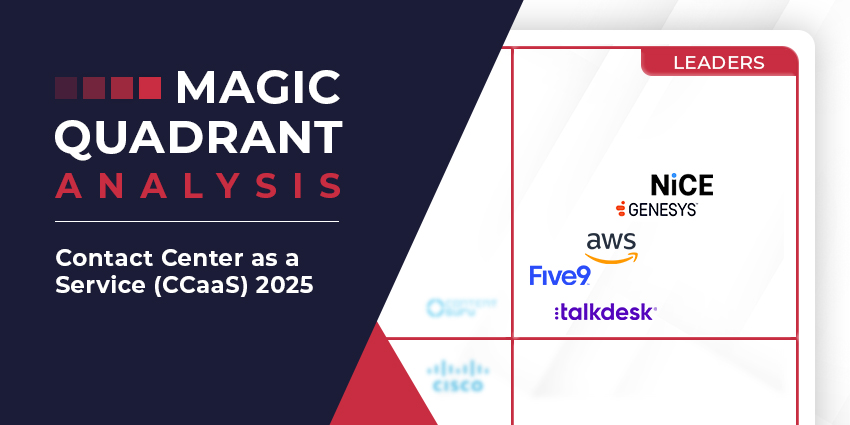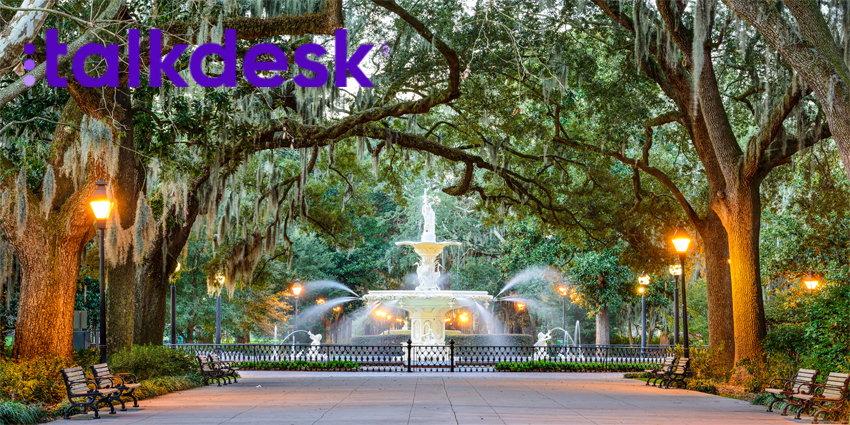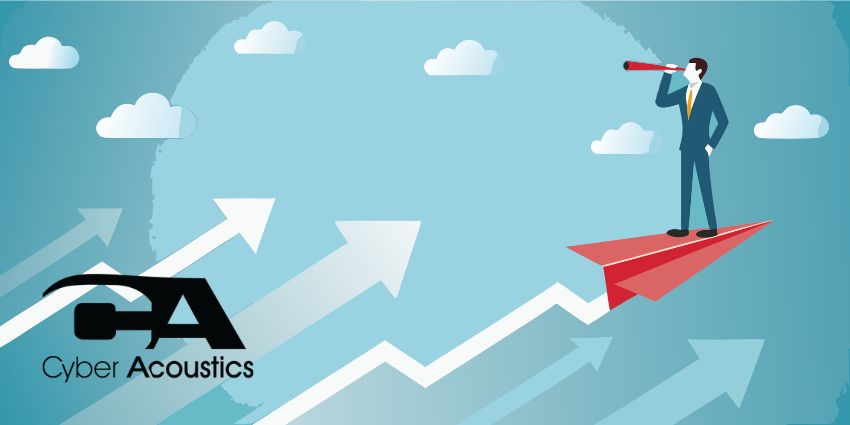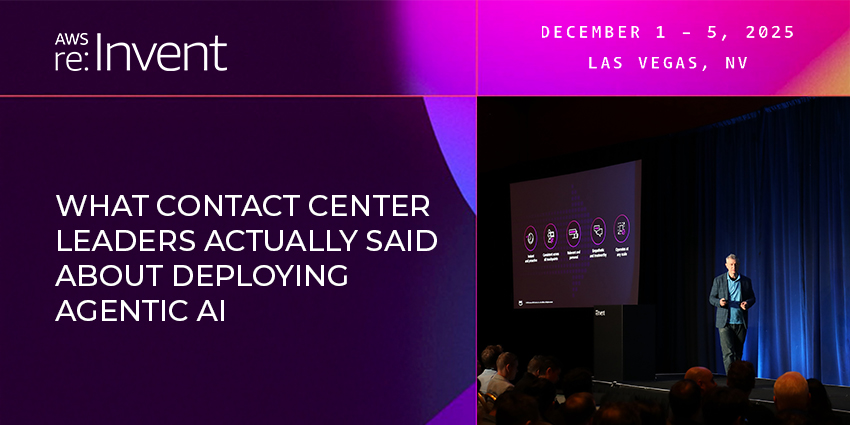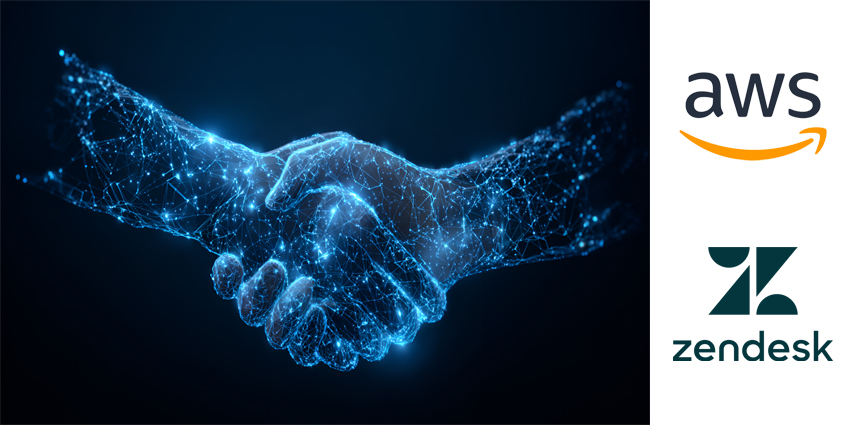The Magic Quadrant for CCaaS is back, and once again, NiCE and Genesys lead the way.
AWS, Five9, and Talkdesk join them in the Leader square, with the latter bouncing back after placing as a Visionary last year.
Content Guru also rises up the pile. It has shifted from the Niche Player quadrant and is now a Challenger. Meanwhile, Cisco moves in the opposite direction.
8×8 has dropped out of the evaluation, yet Zoom enters and takes its place as a Niche Player.
Alongside 8×8, Google, Microsoft, and Sprinklr are prominent CCaaS providers that don’t feature in the Magic Quadrant matrix.
The Definition of Contact Center as a Service (CCaaS)
All cloud applications that enable customer support teams to manage multichannel conversations fall under the term “Contact Center as a Service (CCaaS)”.
The providers included in the Magic Quadrant assemble those apps, both native and third-party, on CCaaS platforms, enabling service experiences led by both humans and AI.
Yet, it’s not all about facilitating conversations. CCaaS platforms will also offer solutions for analytics and reporting, agent assistance, and workforce engagement management (WEM).
While Gartner’s definition is more comprehensive, that’s ultimately what each vendor in the report offers.
The analyst evaluates them on such capabilities, alongside pricing models, support services, integrations, verified customer feedback (stripped from Gartner Peer Insights), and more.
In doing so, the research firm splits nine of the most prominent industry players into four groups: Leaders, Challengers, Visionaries, and Niche Players. Here’s how they performed.
Gartner Magic Quadrant Leaders
Leaders sit in the top right-hand square of the Magic Quadrant, scoring above average in their “ability to execute” and “completeness of vision”. This year’s Leaders are:
- NiCE
- Genesys
- Amazon Web Services (AWS)
- Five9
- Talkdesk
NiCE
NiCE has secured several major enterprise CCaaS deals this calendar year, including two nine-figure mega-contracts.
Key to these deals are its advanced global support services, which Gartner lauds, alongside the vendor’s “technical account manager support”.
Additionally, the analyst pinpointed “advanced AI and analytical capabilities” as a strength. However, it didn’t note how NiCE’s burgeoning enterprise partnerships, with the likes of AWS, ServiceNow, and Snowflake, aid that AI strategy and set the stage for end-to-end, automated resolution flows.
Also, Gartner fails to mention NiCE’s workforce engagement management (WEM) heritage, which continues to be a significant differentiator, especially with the top two third-party alternatives – Verint and Calabrio – set to merge. However, in fairness, confirmation of this merger seemingly came through after the research firm completed its evaluation.
Genesys
Genesys excels in big enterprise deployments, especially from its own on-premise install base, offering tried-and-tested playbooks, process maps, and solutions to make migrations easier.
Gartner recognizes these strengths, alongside its “adaptability and innovation”, highlighting Genesys’s rapid delivery of new, differentiated features.
Somewhat remarkably, however, Gartner doesn’t mention Genesys’s leading role in converging CCaaS and CRM solutions, despite noting this as a key market trend.
Its recent $1.5BN investment from Salesforce and ServiceNow seemingly rubberstamps Genesys’s strategy here, with the two CRM vendors taking learnings from their collaboration with the CCaaS revenue leader and applying those industry-wide.
As that trend kicks into gear, Genesys will continue to play a leading role in converging the customer support stack.
Amazon Web Services (AWS)
Gartner notes that Amazon Connect clients often report their satisfaction with building “functionally rich AI capabilities”, leveraging the broader AWS portfolio.
As this suggests, AWS uses its size well and enables differentiated innovation.
AWS also wins praise for its “customizable solutions”, which seems to reinforce perceptions that Amazon Connect is a platform for the builders.
Yet, the perceptions are outdated. For instance, its major platform re-architecture, announced in March 2025, embedded first-party AI capabilities across its platform, enabling customers to deploy native AI in “just a few clicks”.
As such, Amazon Connect is now more of a solution for businesses that want an “oven-ready” platform, as well as those looking to build. Unfortunately, whether intended or not, this report somewhat reinforces those antiquated notions.
Elsewhere, Gartner praises AWS’s “ability to scale”. Yet, surprisingly, omits its pricing model, which advances on consumption-based pricing. Indeed, it includes a single price for all AI features, lowers costs for AI testing, and ensures customers don’t need to pay for unused seats. That’s often a big deal-winner for AWS.
Five9
Five9 has endured some negative press in 2025 with multiple rounds of layoffs. However, its CCaaS revenue growth held firm, rising at a double-digit rate.
Gartner credits strengths in its “support services” and “broad market fit”, with Five9 growing far beyond its North American roots and delivering successful enterprise implementations worldwide.
Many of those implementations have a “high attach rate for AI Agent functionality”, per Gartner, with Five9 quick out of the gates in releasing AI agent functionality.
That speed reflects deeper strengths in contact automation, with it being the only CCaaS vendor to make it onto CX Today’s top conversational AI providers to watch list in 2025.
Talkdesk
After a two-year absence, Talkdesk is back in the Leader’s quadrant. Its “industry-specific solutions” are a big reason why, as it not only customizes its products to the sector, but pre-packages specialized integrations and workflows to accelerate migrations and innovation.
The solutions have expanded Talkdesk’s market, as Gartner emphasizes. Yet, another key solution that the CCaaS provider released helped here: Talkdesk Embedded.
Interestingly, this solution helps “embed” elements of Talkdesk’s cloud contact center into third-party CRM and helpdesk systems. Not only is that innovative from a platform convergence perspective, but it makes Talkdesk an attractive option for system integrators (SIs).
Lastly, Gartner lauds Talkdesk’s account managers, who have seemingly helped its customer satisfaction levels rise sharply over the past 18 months.
Yet, CTO Munil Shah, who arrived in April 2024, also deserves plaudits. Indeed, since his arrival, Talkdesk hasn’t just executed on its industry-specific strategy but delivered several unique innovations to boost the customer and employee experience. Its AI Rewriter is an excellent example.
Gartner Magic Quadrant Challengers
Challengers in the Magic Quadrant place in the top left-hand square of the Magic Quadrant, excelling in their “ability to execute” but trailing Leaders in their “completeness of vision”. This year’s Challengers are:
- Content Guru
Content Guru
Like Genesys, Content Guru has established a reputation for doing “big” well. Gartner underscores this, alongside the vendor’s suitability for brands with significant scale and customization requirements.
Additionally, the research firm recognizes “high service availability” and “AI service orchestration” as key differentiators for the brand.
However, Gartner doesn’t reference how Content Guru is converging CCaaS and customer data platform (CDPs). That is a big differentiator, as the provider helps its customers to establish an omni-data layer from which all its AI innovation can spring, setting customers up for long-term success.
Given this, it’s perhaps surprising that Content Guru didn’t score better in its “completeness of vision”. Nevertheless, Gartner does raise “negotiated SLAs” and “complex pricing” as two of its cautions.
Gartner Magic Quadrant Visionaries
Visionaries in the Magic Quadrant sit in the bottom right-hand square of the Magic Quadrant, scoring well in their “completeness of vision” but lagging Leaders in their “ability to execute”. This year’s Visionaries are:
- There are no Visionaries in the 2025 Gartner Magic Quadrant for CCaaS.
Gartner Magic Quadrant Niche Players
Niche Players in the Magic Quadrant sit in the bottom left-hand square of the Magic Quadrant. While they have accrued a strong industry presence, their “ability to execute” and “completeness of vision” fall behind the market Leaders, according to Gartner. This year’s Niche Players are:
- Cisco
- Zoom
- Vonage
Cisco
Cisco is one of only two “Customers’ Choice” vendors, which Gartner tagged in its latest Peer Insights “Voice of the Customer” for CCaaS report. That reflects the high satisfaction rates of its install base.
As such, it’s surprising that the analyst didn’t note positive word of mouth as a core strength. Instead, it applauded how Cisco has converged CCaaS with UCaaS and CPaaS. Indeed, this combination boosts the Webex Contact Center in various ways, such as enabling swarming and next-level proactive customer service. As AI agents soon start leading outbound conversations, that latter strength will come increasingly into its own.
Meanwhile, the report also commends Cisco for its “global support network” and “advanced security measures”. The latter demonstrates how Cisco, like AWS, is doing an excellent job of leveraging its broader portfolio to deliver unique innovation.
Nevertheless, it has dropped into the Niche Player Quadrant. Amongst Cisco’s listed cautions are its “multiple administrative interfaces” and “limited third-party integrations”, which are possible justifications here.
Zoom
Zoom only entered the CCaaS space in 2022, but ever since, its innovation streak has gone from strength to strength, while its install base has surged.
Much of that is due to its reputation for delivering consumer-grade tech to the enterprise. Yet, Gartner also pinpoints its “tight UCaaS integration” as a principal reason, alongside its “native AI functionality” and “simplified setup and administration.”
However, Zoom doesn’t just think of CCaaS and UCaaS. On one platform, it delivers both solutions alongside conversational AI, sales intelligence, Workvivo, and many more applications. That single ecosystem sets the stage for original innovation and data sharing that can set Zoom apart.
As such, expect Zoom to rise in the coming years, as it also addresses the “breadth of features” and “third-party integrations” concerns Gartner pinpoints in its report.
Vonage
Like Cisco, Vonage wins plaudits for converging CCaaS, UCaaS, and CPaaS. Its CPaaS offering is particularly strong, though, enabling access to APIs – like 5G network APIs – that strengthen the spine of Vonage’s contact center platform.
Gartner also applauds how Vonage has optimized its solution for the midmarket and its “Salesforce Service Cloud integration”, although the latter doesn’t appear much different from the integrations offered by Genesys and AWS.
Where Vonage does stand apart is in its Intelligent Workspace, which leverages AI to rearrange the screen based on the call, enabling agents to better navigate their desktops.
However, Gartner cautions toward the provider’s “system reporting” and “tendency toward use of CRM partner technology.”
The CCaaS Magic Quadrant: A Third-Party Take
For an extra perspective, CX Today invited Zeus Kerravala, Principal Analyst at ZK Research, to share an alternative take.
Kerravala anticipated NiCE and Genesys would lead the pack again, yet agreed with AWS creeping closer to Gartner’s frontrunners.
“As a late entrant, for Amazon to have made its way into such a strong position in such a short period of time is a testament to how much they have invested in this business, said Kerravala. “They came to market around the same time as Twilio but have certainly set themselves apart.”
Five9 also maintains its place at the top. However, the analyst cautions about its long-term sticking power. While acknowledging its CTO as an industry thought-leader, Kerravala referenced the executive turnover, since Gartner completed its research, as a concern. After all, it likely indicates flux in its strategy.
“[This] shows the flaw in the Magic Quadrant,” he noted. “It’s a document that is supposed to live on for a year but can’t adapt to market changes.”
Nevertheless, Kerravala’s most significant gripe is with Cisco’s drop from a Challenger to a Niche Player. “Gartner’s position does not align with reality at all,” he said.
Cisco CCaaS has shown very strong growth and was a Gartner Peer Insight Customer Choice [provider] for 2025. This shows the disjointedness in Gartner research.
“While I don’t think they’re a leader yet, they have a very high level of execution capability and should be a Challenger or Visionary.”
Lastly, Kerravala stated his belief that Zoom should shift right, citing its vision for enterprise communications beyond CCaaS and UCaaS, alongside “very strong” channel feedback and its “tremendous growth up and down market.”
Delve into additional coverage of Magic Quadrant reports exploring adjacent technologies below:
- Gartner Magic Quadrant for CRM Customer Engagement Center (CEC) 2024
- Gartner Magic Quadrant for Conversational AI Platforms 2025
- Gartner Magic Quadrant for Communications Platform as a Service (CPaaS) 2025
